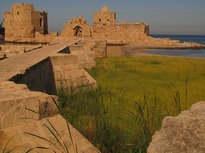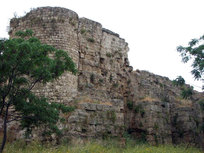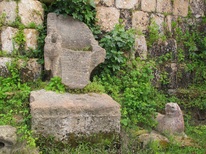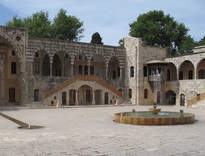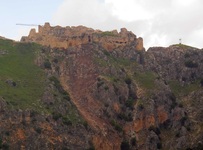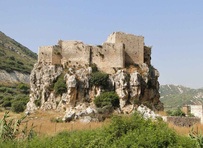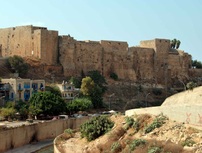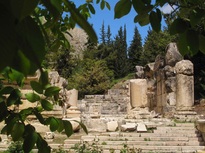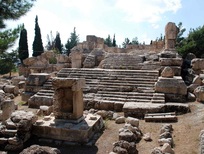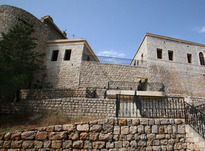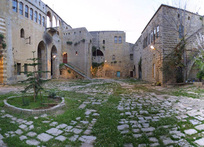Saida is most famous for its Crusader Sea Castle and nearby Echmoun Temple, while some well-preserved Roman temples can be found in Niha and Qsarnaba. A great sample of an early 19th-century architecture palace can be admired at Beiteddine. Other castles can be found in Tripoli, near Arnoun and north of Batroun. In Rachaya el-Wadi and Hasbaya are some elegant Ottoman-style citadels.
Crusader Sea Castle (Qala'at al-Bahr) - Saida
Builtin 1228 on top of a Phoenician temple, the Sea Castle was constructed by theCrusaders to defend Saida’s harbor. The castle was largely destroyed by theMamluks in 1291 to prevent the Crusaders from re-establishing and was restoredby Fakhr el-Dine Maan II in the early 17th century. See more...
Builtin 1228 on top of a Phoenician temple, the Sea Castle was constructed by theCrusaders to defend Saida’s harbor. The castle was largely destroyed by theMamluks in 1291 to prevent the Crusaders from re-establishing and was restoredby Fakhr el-Dine Maan II in the early 17th century. See more...
Ruins of the Castle of St Louis (Earth Castle) - Saida
Located on top of a 10th-century fortification, the Castle of St Louis was built as a Crusader fortress by King Louis IX in 1254. It was the first inland castle constructed in Saida and like many Crusader structures, largely ruined by the Mamluks. See more...
Located on top of a 10th-century fortification, the Castle of St Louis was built as a Crusader fortress by King Louis IX in 1254. It was the first inland castle constructed in Saida and like many Crusader structures, largely ruined by the Mamluks. See more...
Echmoun Temple - Saida
Situated about 1.5 kilometers north of Saida and along the banks of the al-Awali River, are the remains of the Phoenician temple complex of Echmoun. Givenits natural environment, the area is locally known as the `Bustan al-Sheikh`,the Gardens of the Sheikh. See more...
Situated about 1.5 kilometers north of Saida and along the banks of the al-Awali River, are the remains of the Phoenician temple complex of Echmoun. Givenits natural environment, the area is locally known as the `Bustan al-Sheikh`,the Gardens of the Sheikh. See more...
Beiteddine Place - Beiteddine
The construction of the Beiteddine Palace started in 1806, when Emir Bashir Shehab II, the governor appointed by the Ottomans, decided to leave Deir el-Qamar and move to a safer haven in Beiteddine. He hired Italian architects and artisans from all over Syria and after 30 years of construction, the palace was finished in 1818. See more...
The construction of the Beiteddine Palace started in 1806, when Emir Bashir Shehab II, the governor appointed by the Ottomans, decided to leave Deir el-Qamar and move to a safer haven in Beiteddine. He hired Italian architects and artisans from all over Syria and after 30 years of construction, the palace was finished in 1818. See more...
BeaufortCastle (Qalaa al-Shaqif) - Arnoun
Situated 800 meters above sea level and one kilometer southeast of the village of Arnoun, the Beaufort Crusader Castle warrants a detour provided you have your own transportation. Before 1139, the site was a military stronghold of the King of Jerusalem to defend the extreme north of his kingdom. See more...
Situated 800 meters above sea level and one kilometer southeast of the village of Arnoun, the Beaufort Crusader Castle warrants a detour provided you have your own transportation. Before 1139, the site was a military stronghold of the King of Jerusalem to defend the extreme north of his kingdom. See more...
Moussaylaha Castle (Qalaat Museilha) - north of Batroun
Located on a rocky hill next to the coastal highway four kilometers north of Batroun, this early 17th-century castle was reputedly built by Fakhr el-Dine Maan II and served as a look-out post for the seaside road. See more...
Located on a rocky hill next to the coastal highway four kilometers north of Batroun, this early 17th-century castle was reputedly built by Fakhr el-Dine Maan II and served as a look-out post for the seaside road. See more...
Citadel of Raymond de Saint-Gilles (Qalaa Sanjil) - Tripoli
Withits main entrance on the north, the huge 12th-century Crusaderfortress of Raymond de Saint-Gilles was constructed in 1102 on Mount Pilgrimwith the purpose of controlling land trade by blocking the city from the sea. See more...
Withits main entrance on the north, the huge 12th-century Crusaderfortress of Raymond de Saint-Gilles was constructed in 1102 on Mount Pilgrimwith the purpose of controlling land trade by blocking the city from the sea. See more...
Niha Temples
The small and sweet village of Niha is best known for its impressive and well-preserved Roman temple, located between pine trees just west of the village. There are also the remains of another small temple just below. See more...
The small and sweet village of Niha is best known for its impressive and well-preserved Roman temple, located between pine trees just west of the village. There are also the remains of another small temple just below. See more...
Qsarnaba Temple
The old part of this small and friendly village houses the remains of a well-preserved Roman temple. Fenced, it can only be visited if someone opens the gate. Usually, one of the villagers can help you get in. See more....
The old part of this small and friendly village houses the remains of a well-preserved Roman temple. Fenced, it can only be visited if someone opens the gate. Usually, one of the villagers can help you get in. See more....
Rachaya Citadel - Rachaya el-Wadi
The beautiful citadel of Rachaya, now also known as the Independence Castle, was built during the 11th century by the Crusaders in order to acquire an observation post for merchants, pilgrims and travelers. Between 1172 and 1860, it was the seat of power of the Shehab family. See more...
The beautiful citadel of Rachaya, now also known as the Independence Castle, was built during the 11th century by the Crusaders in order to acquire an observation post for merchants, pilgrims and travelers. Between 1172 and 1860, it was the seat of power of the Shehab family. See more...
Shehabi Citadel - Hasbaya
Situated on a hill overlooking the Hasbani River, this large six-floor citadel is part of the 20,000 m2 Shehabi complex, which also covers several medieval houses and a mosque. Originally a Crusader castle, or possibly even an Arab or Roman structure, it was confiscated by the Shehab family in 1170. See more...
Situated on a hill overlooking the Hasbani River, this large six-floor citadel is part of the 20,000 m2 Shehabi complex, which also covers several medieval houses and a mosque. Originally a Crusader castle, or possibly even an Arab or Roman structure, it was confiscated by the Shehab family in 1170. See more...
For information on the impressive Roman Temple complex of Baalbek, click here.


